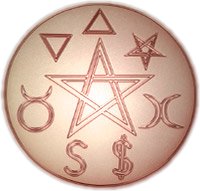I've been working on crafting the Earth Tile for my shrine. Calling it an "Earth Tile" isn't the normal name. Before it was called anything else it was simply the Pentacle. A pentacle is an object with a pentagram drawn or carved on it. Traditional Wicca has a slew of other symbols that they include on their's depending on their degree of initiation. The triangles and smaller pentagram represent those degrees, the horned circle symbolizes the Divine Masculine and the back-to-back crescents symbolize the Divine Feminine and the two S's are symbols for "Mercy/Kiss" and "Severity/Scourge."
Like the blade, there are recommended materials to make the Pentacle or Tile out of. Of all the tools, this one is deviated on the most in both substance and in image. It's supposed to be made of a masculine material. Though this is generally a metal such a bronze or better-yet gold the Pentacle is most often made of copper, which is the metal associated with Venus, and hence a feminine material. A masculine wood would work and the most common of those is Oak.
Eclectic (or non-traditional) Wiccans and other NeoPagans deviate on every aspect of the tradition standards of the altar tile, incorporating other symbols, leaving it at just a star (and not always a five-pointed one) in a circle or some other shape or changing the focal symbol all together. These variant tiles have been made in every conceivable material and I've even know temporary ones to be drawn out on paper. The fun part about all these variations is that most of them do not take into consideration exactly what the altar tile is for.
As the tool for the element of Earth the tile is to center and ground or lock energies into place. So, at the end of any ritual in which the practitioner has charged an object with magical or psychic or divine or whatever sort of energy they place it on the tile to lock it into place. When it comes time for the Sacred Meal this tool takes on an even more specific role: the role of the Sacred Serving Plate. The tile becomes either a platter or the base of another platter upon which the cakes at set.
This last image is what I've decided to put on my altar tile. As a symbol and tool of the element of Earth goes, this one is fairly well rounded. The overall symbol is called a "squared circle" that is a circle with an equal armed cross inside. On top of being the astronomical symbol for our planet it represents the ritual circle that is supposed to be a plain of existence in and of itself. The other four symbols are the symbol for Earth in four different cultures: (Starting from the top left, moving clockwise) Adinkra or West African, European Alchemy, Chinese Hanzi, and the Mayan Glyph. I've painted this on a round mirror in brown and yellow furthering the symbolism.~ A. Fox





